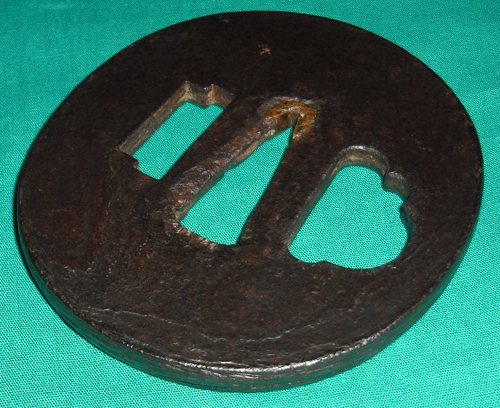TEKKOTSU = iron bones
On steel tsuba, some cores become visible by wearing.
Hand made steel is not homogenized completely. Especially for tsuba, extra
forged steel is not necessary, because it is not a blade. The fold welding
work for tsuba may be rougher than the work for blade. So, a steel tsuba
in old days had uneven quality of the material.
By long time wearing, some parts of the tsuba are easy to be removed, and
some parts are hard to. Then the surface becomes uneven naturally. The
rim becomes the most effective by wearing. The hard parts rise up like
ribs that come up on the human's body. Usually it appears on the rim, like
ridges or lumps. Rarely it is on the surface.
We appreciate such an appearance, as a proof of good ageing and good steel.
We call it "TEKKOTSU", it means iron bones in the literal translation.
Tekkotsu does not appear on all the steel tsuba. A tsuba with tekkotsu
is not common.
Sometimes we find it on the tsuba before 16th century. The Owari and Kanayama
style tsuba are famous for its powerful appearance of tekkotsu.
Tekkotsu becomes rare coming close to the modern age.




I suppose several reasons why tekkotsu becomes visible.
- The steel is not fully homogenized.
- It includes some percentage of a good steel, that is hard to grow rust.
- The tsuba has been worn on a samurai's waist for a long time, maybe more
than hundred years.
- It has been kept in good treatment, the tsuba was never covered with
deep rust in the past.
Therefore a tsuba that can't appear tekkotsu may be;
- The tsuba is made of all soft steel. Such a tsuba has deep rust on all
the surfaces and no smooth part. Most of cheap tsubas are that.
- The steel is completely homogenized. It may be necessary as a material
to make a fine carved metal art. For example; famous artists' tsuba in
the Edo period (17th - 19th century).
- The tsuba made of cast iron. It is not a tsuba but a toy.
Important:
TEKKOTSU is not the same thing as a visible layer pattern made by a chemical
treatment.
This layer pattern is not a tekkotsu.

=> The method of
making a tsuba steel with tekkotsu
------------------------------------------------
<An advice from a customer>
What causes natural tekkotsu?
When this mixture of soft and
hard steel, the tsuba, rubs against clothes, the softer steel wears away
and leaves the harder steel behind. Therefore you get bumps, ridges, and
ribs of hard steel - tekkotsu! A once smooth rim now is uneven but left
behind is clear evidence that this tsuba saw much time at the side of a
samurai. The smooth skin now has the hard steel ribs, the "iron bones,"
showing!
The literal Japanese-to-English translation of the description of some
tekkotsu uses the word "powerful." Perhaps it is an emotional
reaction to the tekkotsu. It is the impression this wonderful tekkotsu
has on the examiner. But maybe some tekkotsu is called "powerful"
because a large quantity of tekkotsu means the tsuba is strong. It means
it had much hard steel in comparison with soft steel. It served its wearer
well.
-----------------------------------------------
Home > Terms > Tekkotsu